« Chronique:Canon Fodder - Pen Umbra » : différence entre les versions
Page créée avec « 1000px|center '''BY GRIMBROTHER ONE - 10/7/2020''' '''ISSUE 109''' See, I told you it wouldn’t be too much longer before we... » |
m Hawk a déplacé la page Canon Fodder - Pen Umbra vers Chronique:Canon Fodder - Pen Umbra |
(Aucune différence)
| |
Dernière version du 7 octobre 2020 à 20:01

BY GRIMBROTHER ONE - 10/7/2020
ISSUE 109
See, I told you it wouldn’t be too much longer before we’d meet again. Welcome back to Canon Fodder, our semi-kinda-regular-ish feature that focuses specifically on Halo’s lore and underlying universe. Maybe you just like suiting up and flinging plasma at alien alliances for acclaim and Achievements, but don’t mind a side of space opera now and then. Maybe you pride yourself at being a deep-diving leave-no-lore-behind type of story-sleuth. Good news: we’re here for every flavor of fiction fancy! We also provide an inordinately unhealthy offering of alliteration, so, apologies in advance for that part.
Anyway, today we’ve got a sweet slate of Halo universe-related goodies for you, primarily to celebrate the upcoming release of our latest novel, Halo: Shadows of Reach. Penned by renowned Spartan scribe Troy Denning, Halo: Shadows of Reach sees Blue Team head back to their old stomping grounds to acquire assets for Dr. Halsey. Assets that she feels might just be a vital part of the solution to stopping a certain digital dictator before they can truly exert their will on the galaxy.
Halo: Shadows of Reach in many ways is as important for what it is as what it’s not. It’s not “required reading” in order to understand or enjoy Halo Infinite. Fans that devour the novel will be right in the same starting point when they boot up the game as fans that don’t. In many ways, it occupies a very similar space as the original piece of Halo fiction—Halo: The Fall of Reach. That novel provided a state-of-the-universe table-setting that gave eager fans a glimpse into some of the deeper motivations and surrounding character moments that took place in the time before Halo: Combat Evolved. Halo: Shadows of Reach sits poised to fill a similar role.
In case of emergency: Break glass[modifier le wikicode]
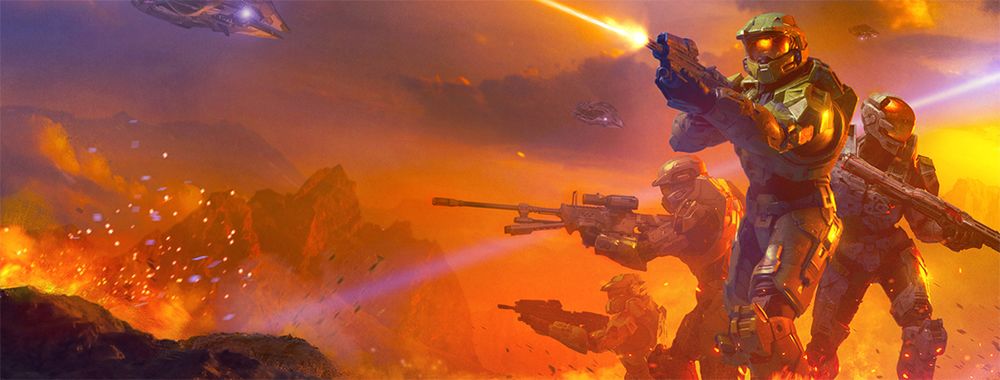
To talk a little bit more about what to expect from the upcoming story, I sat down with Troy and Halo Franchise Lead Editor Jeremy Patenaude to discuss particulars on both process and priorities.
GRIM: So, it feels like we’ve been going back and forth on this book together for so long now it’s almost kinda weird to sit down and discuss it as a finished product! Troy, what were your first thoughts on the initial idea?
TROY: When Ed [Schlesinger, Simon & Schuster/Gallery Books] asked me to write the book, the first thing he mentioned was that it would be a Blue Team novel with connective tissues related to the Master Chief’s role in Halo Infinite—and I was sold. I just love the Halo universe and characters, so writing a novel that moves the timeline forward–and helps whet the appetite for Infinite–is definitely something I was interested in. (Who wouldn’t be?)
GRIM: Right? And of course, you’re no stranger to Spartans, particularly Blue Team, but this story in some ways is meant to fill a unique role. Was there anything specific that excited you about the prospect of writing in this particular time period, with these particular characters?
TROY: Definitely, as it gave me a chance to explore some of what has happened to John and Blue Team after Silent Storm and Oblivion, where they’re still in their mid-teens and just starting to come to terms with what the UNSC has made of them. In Shadows, they’re in their mid-forties, which means they’ve been in the thick of high-intensity warfare for thirty years–and they’ve endured it pretty well. I really enjoyed examining how their early experiences changed them, and the kind of armor that they’ve had to grow on the inside to protect their emotional well-being as efficiently as the Mjolnir that protects them physically.
Another thing that excited me was that I knew I would be working with some good people on an important project.
GRIM: Wait, who else are you working with?!
TROY: Ha!
GRIM: Actually, Jeremy, can you talk a bit about the role 343 plays in the process of putting together a book like this?
JEREMY: Absolutely. Every book comes together differently on our end due to a number of factors that we might be juggling at any given moment. With a project like this, our team had a pretty strong feeling that we should return to the roots of the franchise by returning to Reach, and so we had a high level understanding of the goals of this story at the very beginning. Our first step, however, is always engaging the author and bringing them the high level idea, and then allowing those conversations and really the author’s own talent and love for the universe to shape what follows. This is where the story is born and we’re enormously grateful to have Troy Denning as one of those authors for Halo.
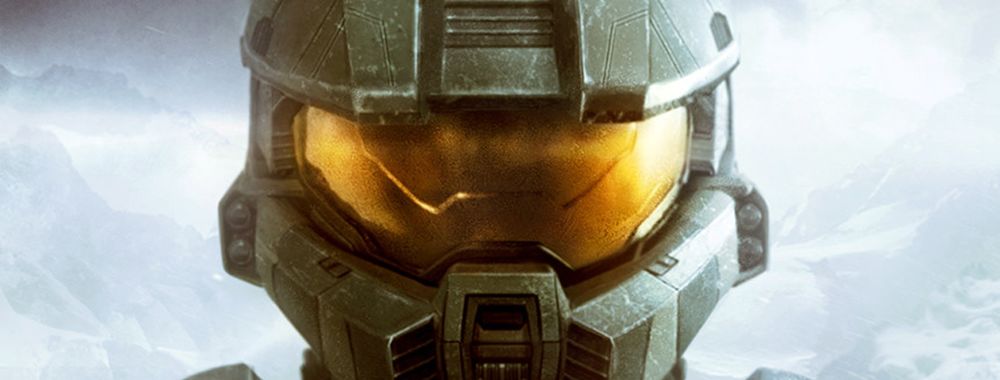
GRIM: Couldn’t agree more, and what’s even better is that the fans certainly seem to share that same sentiment.
JEREMY: He’s not only a master storyteller that knows our universe, but his knowledge isn’t just the broad strokes, he gets the nuance and really the spirit of the Halo, which is extraordinarily difficult even for a lot of talented authors. Troy really gets Halo. On the franchise team, we have a passion for these books to remain true to the spirit of Halo, even as characters and events progress forward in the universe’s narrative. Troy and our other talented authors are essential to that end.
So that’s how the process begins, and from there it’s many iterations and evolution, with Troy driving the story telling and our team responding with any feedback we feel is helpful to guide the project. In this book, we had regular calls because we all knew that it was dealing with a story that would be very important to fans, the Spartans returning to Reach in a very real way.
GRIM: And it’s certainly not just us that are directly involved on projects like this.
JEREMY: Not at all. Critical to this whole process are people like Ed Schlesinger, who not only shepherds the project from Simon & Schuster’s end, but also provides rich insight into the Halo universe without which our books would greatly suffer. Tiffany O’Brien and Scott Jobe, on Consumer Products, really drive the project from our end and keep people like me or you, Jeff, on point when it comes to dates and deliverables.
TROY: And I’ll say that 343 is great about giving its writers the latitude to write a story that excites them while at the same time providing an envelope to work in when it comes to certain key elements. For example, 343 wanted Shadows to give a glimpse into certain plot points that also come to fuller fruition within Halo Infinite, and often times this can mean that certain elements I’m writing in my manuscript are brought to life in parallel with ones being developed for Halo Infinite'’s story and gameplay.
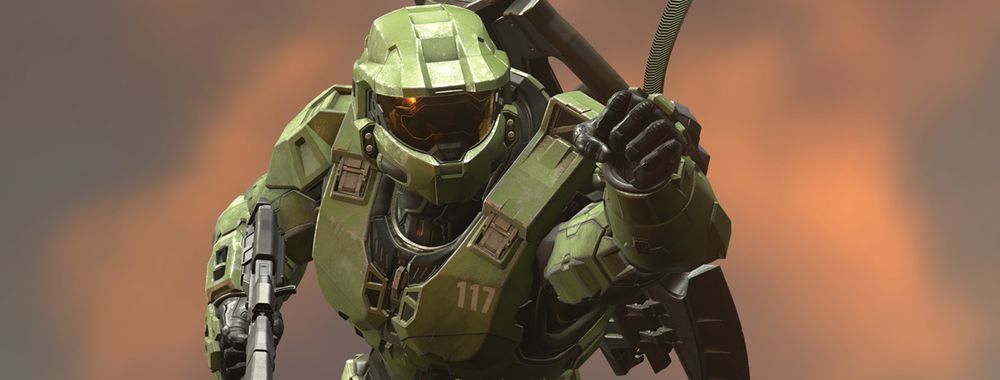
GRIM: And that of course can bring its own unique challenges for sure. I know personally as someone working on both the campaign for the game as well as stuff for this book, it’s always interesting to try and keep a close eye on both streams to make sure that things match up in a consistent way, even if for example, it’s the final name or behavior for a weapon or piece of equipment.The nature of game development can mean that all of a sudden you might need to adjust how a particular gun fires or the way you might describe an item's visual depiction.
TROY: Definitely, and I think we all knew from the beginning that there would be some in-process changes to my story, and there certainly were. But my previous experience with the 343 gave me confidence that they would do their best to minimize any disruptions caused by changes on their end, so I felt comfortable accepting that there was going to be a certain amount of fluidity in the source material. I just wrote an outline that was even more detailed than usual, so 343 would have a clear picture of what I intended and be able to alert me when it was necessary to adjust.
We also had biweekly conference calls to keep me up-to-date on developments in the game. The process was even smoother than I expected, and while we did make a few mid-course adjustments, none of them were difficult–not at all.
GRIM: Jeremy what are your thoughts here? What changes about the creative process when the timing or nature of a book requires keeping an even closer eye on other threads, like an upcoming game, etc? I know the Halo Infinite campaign in some ways has been referred to as a spiritual echo of the original Halo: Combat Evolved, and there’s an interesting—and intentional—parallel to be drawn to where we are now in regards to the pairing up of products.
JEREMY: Exactly. Our main goal here was to create a kind of spiritual sequel of Halo: The Fall of Reach that sprung up on the heels of the dark and tragic events of Halo 5: Guardians. We wanted to capture a pivotal moment in time through the lens of Blue Team on the world in which they’d been forged, and that’s really the primary focus of this story from my perspective.
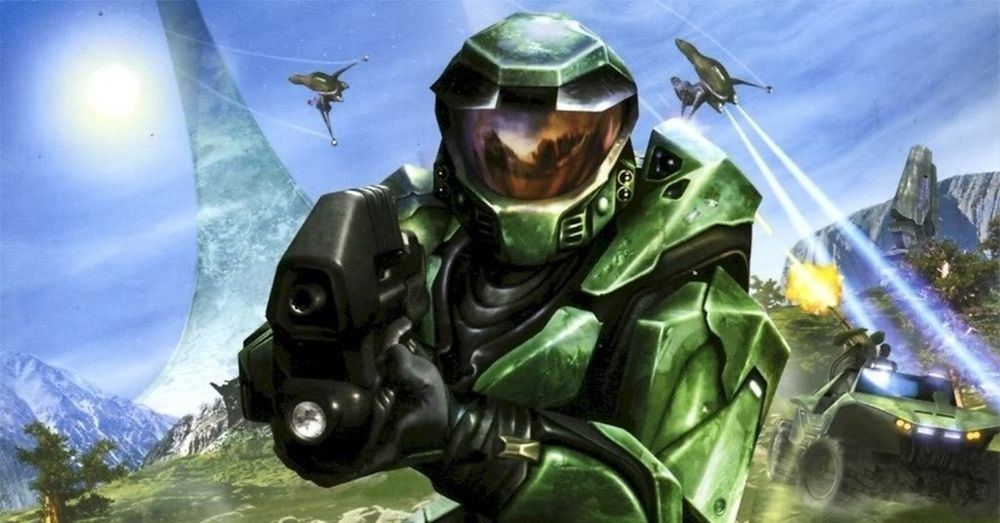
GRIM: But of course, similar to the original novel’s relationship to the original game, you can absolutely enjoy one without the other—and that’s by design.
JEREMY: Correct, every book we release is designed to be a standalone product, meaning that someone can enjoy the book’s story without having interacted with other parts of the universe, and vice versa: this story, as amazing as it may be, is not essential to enjoying other Halo projects, whether released before or after. This is no easy task, especially when your desire is that every aspect of the universe is at all times relevant and meaningful for our fans. We always want to be extraordinarily careful with how this happens and I credit both Troy and Ed for always being very amenable, allowing us to shift and adjust elements throughout the process.
While I’d strongly caution fans to not read too far into anything in this novel or try to reverse engineer story points for the next game, we certainly worked hard for elements like the Chief, the Banished, and the general state of the universe to be entirely consistent, true, and in lock-step with everything we’ve done before and everything we’ve planned for in the future.
GRIM: Exactly, and I think setting up those expectations properly is obviously important to setting those stories themselves up for success.
JEREMY: Fans should come to this book expecting a thrilling story with Blue Team fighting for humanity’s survival on Reach, but now in the bleak shadow of all that took place in Halo 5: Guardians. And I hope fans are very pleased with all the hard work poured into this book.
GRIM: Troy I want to go back to something Jeremy alluded to earlier about your preparation and passion for this type of storytelling. You’re known in many ways for your ability to describe in detail a wide range of scenarios in military fiction. What is some of your process and inspiration there?
TROY: So I started my career as a tabletop RPG game editor and designer at TSR Hobbies, which exposed me to a lot of tabletop wargame players. This was an esoteric form of gaming even then (which was before the Commodore 64 was launched), so I suspect that some Canon Fodder readers may not be familiar with these kinds of monster games: played over a period of 40 - 60 hours on two or three 22" x 32" paper maps, with thousands of ½" counters representing units, supply status, commanders, etc. But I loved playing them and was hooked from my first play of SPI’s Terrible Swift Sword. The games were created as simulations of battles such as Gettysburg and Waterloo–and sometimes of entire wars–so I learned the rudimentary basics of tactics and strategy playing them.
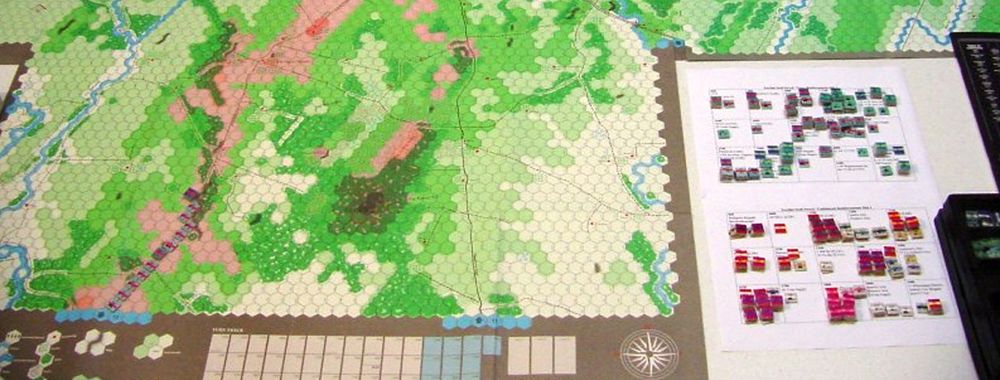
GRIM: And it just grew on from there?
TROY: Absolutely. The more I played, the more interested I grew in the history of the battles we were recreating. So I began to read battle and war histories, which gave me a reasonable feel for tactical thinking. That’s not to say I’m tactician–I’m not. But I understand some of the things soldiers worry about at various command levels, which allows me a window to look through when I write about military characters. I still make mistakes, but understanding the process allows me to create a certain verisimilitude in the story.
Plus, I do my research. I literally sit down and read military manuals, handbooks, and guides from cover to cover (a few pages at a time–I’m not a total masochist). This helps me understand how the equipment works–and how it doesn’t. And it helps me with the voice of my characters. It’s not unusual for people to assume I actually served in the military–which I consider the highest compliment possible for these stories. But I didn’t. It’s all book learning.
GRIM: I’m not gonna lie, it’s pretty incredible to witness, and I love being fortunate enough to watch that process unfold as these books are coming to life. I love gleaning knowledge and practices like these that I’m then able to apply to other projects I’m working on. The military tactics and foundations found in Shadows will feel like a natural extension to folks who have also enjoyed books like Silent Storm and Oblivion.
Of course, fans familiar with your work in the Halo universe know that you also have other threads that have offered their own unique perspective. With that in mind, how does Shadows differ from something like say, Last Light or Retribution?
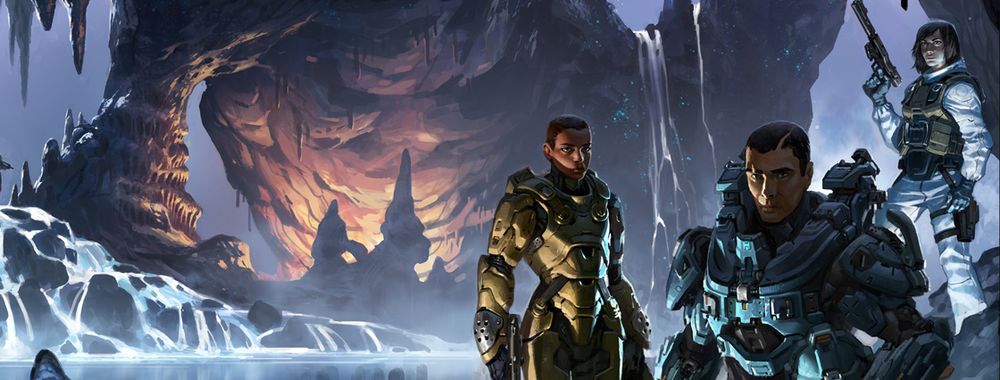
TROY: The most important aspect is probably scope. The Veta Lopis stories are very personal, focused on her and a tight-knit group of compatriots. She is certainly heroic, but it’s a heroism of personal triumph. She makes agonizing choices without knowing whether she’s crossing the line between right and wrong. Her decisions may bear huge consequences for the galaxy, but they also bear enormous consequences for her. In her stories, the thing most at stake is her own identity–whether she will remain true to herself or allow ONI to shape her into just another tool . . . or fall prey to cynicism and become the kind of agent who thinks of herself first and last.
John and Blue Team certainly have their internal struggles, but they have no doubts about their identities. They were created to protect humanity from all comers, and they embrace that purpose wholeheartedly. Their struggles tend to be more about process than morality. Is John being the best leader he can be, or is there something he can do better? Is Fred allowing himself to be distracted, or just maintaining situational awareness? Is Kelly allowing her personal animosity to influence her judgment, or should she trust her instincts?
GRIM: And there’s also a difference in scale from a “state of the universe” standpoint, considering the types of situation the Chief, and often his teammates, find themselves in.
TROY: When John and Blue Team are on the page, the scale is huge. We’re talking the fate of worlds, with clashing armies and burning navies—and we see that happening, because Blue Team is always in the thick of it. When Veta and the Ferrets are on the page, the scale is much smaller. There might be a battle, but it’s limited to a village or space station. The fate of worlds might be at stake… but only because Veta has found herself caught up in a game of dominoes, where what she sets in motion has consequences no one can see.
Which is one of the things I love about writing for Halo. There’s a place for both kinds of stories–and a dozen others besides. It’s an incredibly fertile story setting, and I’m honored to be a part of it.
GRIM: Do you have any favorite characters in this book?
TROY: Yeah, I do. John and Blue Team and Castor, of course. But that’s only to be expected, given how much time I’ve spent writing them.
GRIM: For sure, what about someone folks might not guess right away?
TROY: The favorite that most people will find surprising is probably Bella Disztl, a cross-continent buggy racer who has returned to Reach to help reclaim her home.
GRIM: Oh man, as a motorsport fan, Bella has my heart as well I can assure you.
TROY: She only appears a few times, but she’s one of those characters who just blossoms in your mind when you need to give a little flavor to a pretty generic role. I needed someone to drive John and Kelly somewhere, and I found John thinking that he’d rather be behind the wheel, and Bella Disztl, three time winner of the Tantalus 10,000, was born. I had so much fun putting John in the passenger seat with her that I kept bringing her back, and she ended up serving a much more important purpose in the book than I had imagined.
GRIM: Jeremy how about you, any characters stand out for you?
JEREMY: Inslaan ‘Gadodgai grew on me from the very beginning of this story. He’s a very mysterious Banished Sangheili who Troy just nails in execution. The subtleties of his character, his own convictions, and how he interacts with others—he’s just a very enjoyable and unique Sangheili character that I think fans will gravitate to.
GRIM: And don’t act like I don’t know you want to mention Castor.
JEREMY: I’ve always had a soft spot for Castor from the earlier Denning novels, and so he’s great to follow in this story as well. He’s a deeply complex character grounded his own certainties about the universe, even after the demise of the Covenant should have eroded them, and yet here those certainties clash hard with the Banished’s own ideology. Even though he’s an alien and he’s fighting against our heroes, Castor feels very real for the reader every step of the way. You may disagree with him, but you also find yourself rooting for him.
There are other characters who shine brightly in this story, but it’s hard for me to not mention Blue Team, with Chief at the center. If fans loved Blue’s portrayal in the earlier Denning novels, they’ll really love them here, now jumping forward over thirty years of war and bloodshed that have helped mature them.
GRIM: From your perspective, what should fans expect to gain from this book in regards to its place in the universe and overall timeline?
JEREMY: Our main desire here was to bring Blue Team back to Reach and to do that in the shadow of the events of Halo 5: Guardians. For many fans, Halo: The Fall of Reach represents the foundation of the franchise’s deeper story roots. While Halo: Combat Evolved brought droves of gamers into the universe through an amazing tale and extraordinary gameplay, Eric Nylund’s Halo: The Fall of Reach is what really fleshed out the universe for those who wanted more.
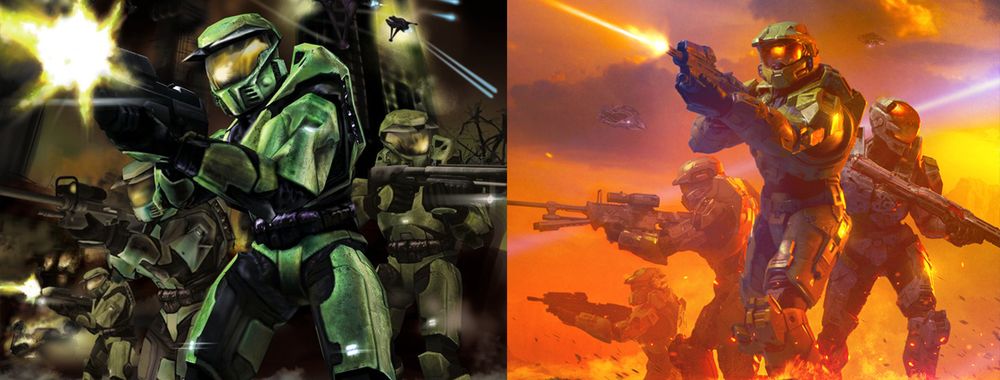
We knew that this was a place we’ve wanted to go back to for some time, and to do so in a way that thematically complemented the original story. Fans should go into this novel with the expectation that this story moves the universe’s overall narrative forward in the wake the traumatic events of the last game by returning to its roots, the place where it all began. There are elements that touch on Halo: The Fall of Reach, Halo: First Strike, and even the game Halo: Reach that we hope fans will be pleased with.
They should also expect further introduction to the Banished, the enemy which takes center stage as the main threat to humanity in both this story as well as Halo Infinite. This isn’t entirely new for those who’ve played Halo Wars 2 or read Halo: Rise of Atriox, but it does offer new details on who they are and what they’re like.
GRIM: Indeed, and to reiterate, this isn’t a story that anyone needs to read in order to “understand” the events in the next game. That being said, it’s also fair to say that readers of this book will be rewarded with cool connective tissues that they might recognize not just in Halo Infinite, but as you mentioned, having ties to several other stories in our universe in a variety of mediums.
Troy, take us home, what do you hope fans get from Shadows of Reach?
TROY: First and always foremost, a good read. When someone tells me they couldn’t put one of my books down, I know we’ve connected. There are so many different kinds of books out there, and so many different kinds of readers, that making that kind of connection is rare and special. Even after thirty years of writing, I’m still thrilled when it happens.
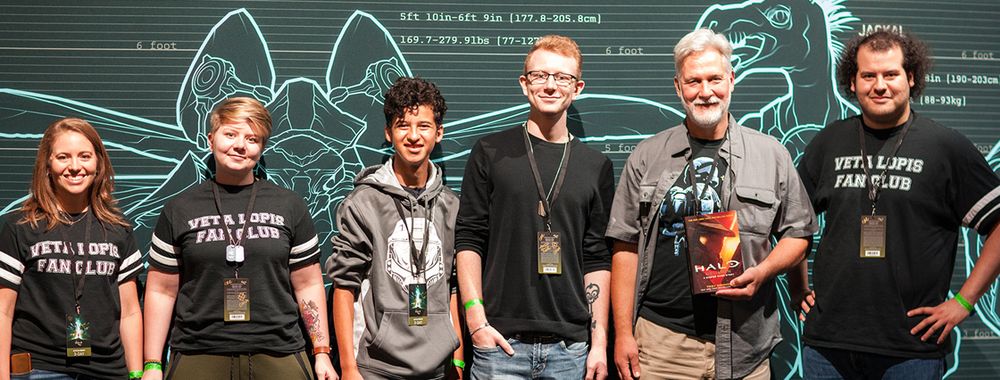
In terms of Halo, I’d like readers to enjoy seeing Reach again. It’s core to the Halo experience in a way that I’m not sure even Earth is, and it was an honor to be the one bringing the story back to it again. It’s only a short visit, so we didn’t even try to visit every touchstone.
And that’s only fitting. There are hundreds of stories on Reach, and I’m not arrogant enough to think I could or should hog them all to myself. I have a feeling that Reach is going to be a place that Halo authors keep returning to for a long time.
GRIM: Full circle, I love it.
Extra Contentedness[modifier le wikicode]
Last issue, we noted that the Wal-Mart edition of Halo: Shadows of Reach will include an additional short story entitled “Sacrifice”—the title of which, obviously worried no one. First off, this additional piece of content tells an incredibly cool story all its own—certainly self-contained but still connected to the novel in a unique way. Second, you really shouldn’t worry about the title. It will make sense, trust me.
If you’re interested in the best way to nab first dibs on this particular chapter of lore goodness, plan on picking up your copy of Halo: Shadows of Reach in Wal-Mart stores or online, and keep an eye on the Halo Gear social channels for updated info on availability. Enjoy!
Troy University[modifier le wikicode]
Before we move on fully from waxing poetic about Shadows, if you’re interested to hear a bit more about the process, we’ve got two of our panels from last year’s Outpost Discovery tour on demand and available to check out—they both feature our man of the hour, Troy Denning, along with a curious cast of canon-crafting characters, all talking about storytelling in the Halo universe. If you’ve never seen these before and are interested in how stories get made, they’re well worth the watch!
The Write Stuff: Chicago[modifier le wikicode]
The Write Stuff: Anaheim – Part two[modifier le wikicode]
A Cold Day in Helmet[modifier le wikicode]
You weren’t dreaming. It’s finally real. For nearly a decade, fans have discussed in hushed whispers (and not so hushed videos, tweets, and forum posts) the mystery and mystique surrounding one of our universe’s greatest urban legends—Halo: Reach’s fabled “GRD” helmet. Jumps were tricked, buttons were pushed, and runs were sped, but eventually the speculation and supposition turned from ARG to ARGH.
Of course, those of you who have already checked out last week’s MCC Development Blog (which by the way, was awesome, and you should read it regardless) will have learned that the hallowed Halo helm is indeed finally on its way to Halo: Reach within the MCC. Of course, the naming convention might have been a little bit different than originally assumed. Let’s check it out.
The base equipment here is actually the AKIS-class helmet, developed to employ a wide array of targeting and surveillance-focused features to maximize range-finding capabilities for both individual groundside operatives as well as F-99 drone fighters and S-14 strike craft, among others.
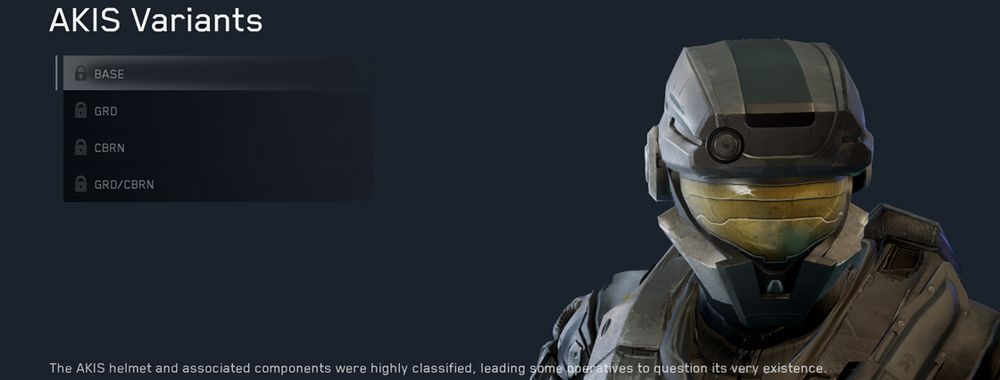
But the real tactical advantages begin to come to the forefront when paired with certain modular upgrades, many developed in parallel with the base AKIS loadout. One such example is the P237-THEIATEK optical suite, developed internally by a joint wholistic team featuring researchers from Watershed Division, Materials Group, and select grad students from the Applied Sciences program at Koletre-Browning University.
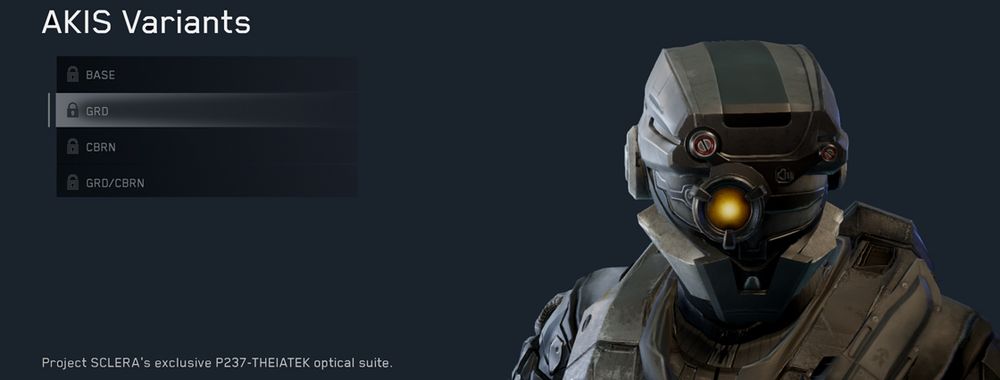
The P237-THEIATEK is a high-end imaging sensor and processor package that integrates directly with UNSC aerial reconnaissance platforms. The GRD (ground resolved distance) software and hardware enhances how much usable intelligence can be gleaned from UAV and satellite-based surveillance imagery.
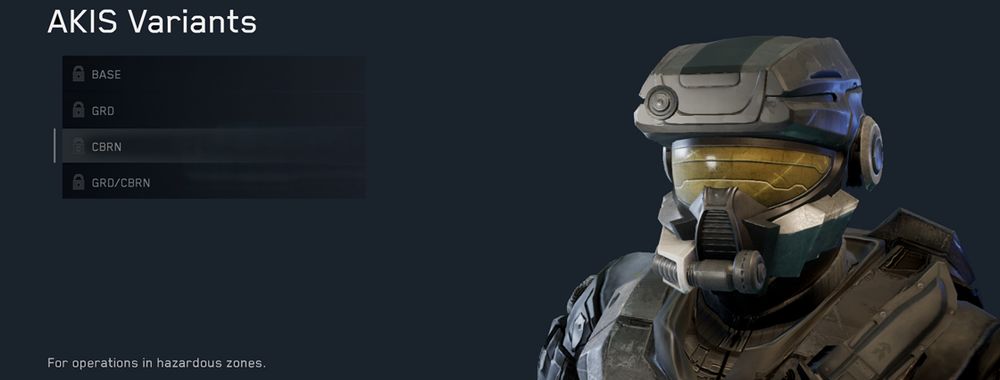
To add to the range’s versatility, a modular CBRN (chemical, biological, radiological, and nuclear) filter has also been developed with full compatibility and hazop compliance for surveillance missions in noxious or irradiated zones.
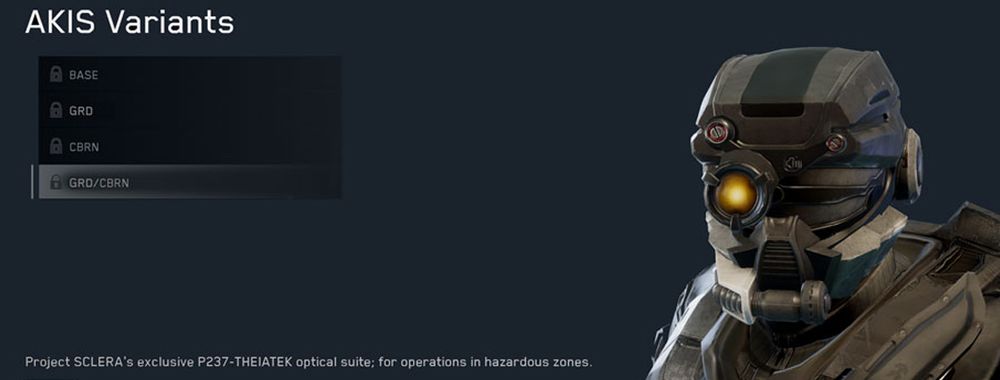
And if you think that AKIS is cool, there’s another helmet we’ve got in the works that might have otherwise been condemned to the cutting room floor if not for the stalwart efforts of the MCC team. But we’ll talk about that one another time…
ONI Eyes[modifier le wikicode]
In case you missed it, the recent release of Halo 3: ODST on PC as part of Halo: the Master Chief Collection was also accompanied by the latest episode in our ONI Archives video series. Before we go on, you can check it out right here:
One of the most fun things to do after things like this drop is to keep a side-eye on the reactions and speculations folks have, always ranging from eager and excited to constructively critical and every curiosity in between. One thing we’ve seen come up is musings on the nature of this type of content in general, so we thought it might be helpful to provide a bit of additional context, both from a canonical perspective and a creative one.
Like many similar pieces, there are often two factors to consider, the tangible priority and the narrative one. Think of it kinda like adding a new piece of armor to a game; there’s the element of adding new content that the player can use to customize their character and encourage progression and/or interaction with the game or product, but then there’s also the narrative element of how that item fits within our universe. Sometimes it’s as simple as a lore string in the UI, and sometimes it’s a deep and involved storytelling vehicle.
So that brings us to the ONI Archive videos. The real-life tangible priority stemmed from thoughts like “Hey, we’re releasing all these new game experiences to folks on a new platform (PC), many of whom either might not have played these in a long time—or perhaps maybe never before at all! What is a way that we can both introduce and catch folks up to set them up for each game’s story?” The initial inclination was of course to draw from the long-running and popular “Halo 101” style videos that have been part of the Halo Waypoint repertoire since it was an app on your Xbox 360 (*looks off into the distance and salutes*). Basically videos that would introduce viewers to the major players and events involved with each game, helping to set the table for their upcoming experience, and also recap things as a reminder of what has come before.
Of course, the problem (air-quotes necessary? Maybe) with having folks like yours truly and Franchise Creative Producer and teammate Tyler Jeffers at the helm of such projects is that we go “yeah but what if we added an additional cool twist to it?” And so the idea was brought forward to do the 101-style videos like normal, but provide a neat narrative framing that would in many ways tie the video itself into our universe and provide us with a unique storytelling opportunity to play with. The video itself would become part of an “educational” series produced by ONI aimed at informing UEG citizens of pivotal events in humanity’s recent history, while simultaneously hopefully inspiring the next generation of heroes looking to follow in the footsteps of the Master Chief.
Of course, we also knew that going in, lots of Halo fans would already be well familiar with the events described in the main videos, and so we thought, what if we include pieces of a small audio drama at the end of each entry, giving fans who might have otherwise passed over such pieces a cool little reason to keep tuning in. A wink and a nod to the folks who “know all that stuff already,” including little deep-cut inclusions like certain interesting names popping up along the way. We landed on telling a canonical story in a corner normally (and understandably) left unexplored: the in-universe production crew side of the equation.
So why should you care about some random ONI Section III comms officer and their co-workers? Well, I suppose that is indeed the question isn’t it? In many ways, the series allows us a welcome opportunity to explore new and unique storytelling avenues, both from a medium perspective and a subject focus one. The Halo universe is incredibly vast, and one that has literally millions of stories to tell, but not all of them are the right fit for a game, or even a novel or comic series. It’s been fun to offer up a small narrative morsel to fill a tiny bit of time during the wait for the next big game adventure in Halo Infinite, and the conclusion to our current ONI Archive story arc isn’t all that far away.
And it’s been even more fun to bring it to life alongside awesome production and creative colleagues at 343 like Phillip Harvey, Jesse Stipek, Nina Marien, Daniel Macadangdang, Drew Benz, John Junyszek, and the amazing and aforementioned Tyler Jeffers. With the release of Halo 4 on PC within the MCC, we’ll look to put a bow on this particular thread—but it doesn’t mean that we’ll be done with experimenting with fun new ways to bring you into the Halo universe.
And with that, we come to the close of this edition. Oh wait! Actually, before we go, if you didn’t get a chance to see Polygon’s own Brian David Gilbert recount his journey through reading all of the Halo novels, you’ll definitely want to give this video a watch. We found it hilarious, heart-warming, and a bit all-too-admittedly-accurate in a few instances. Give it a watch!
Also, if you missed our last edition, it was a bit of a doozy. Issue 108 introduced fans to a brand new character that will be featured in Halo Infinite, Sangheili blademaster Jega ‘Rdomnai (which if I’m not mistaken, also has an action figure out now!). Plus, we take a peek at the lore behind some snazzy new Mjolnir armor that all the cool Spartan-IVs are wearing these days. It was rad, go read it. And if you already did, just click it anyway and inflate my viewership stats a bit. A noble cause if there ever was one, I say!
Anyway, with that—for real this time—we part ways. For now, at least.
Until next time… Live well, play Halo, and GO BOLTS!!!